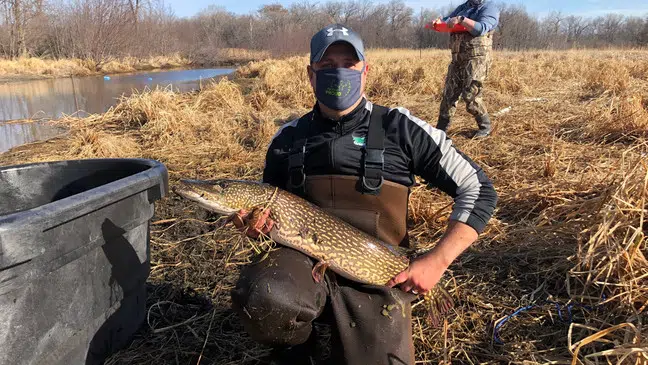SUAMICO, WI (WTAQ-WLUK) – The northern pike spawning run is underway in some areas. Last year, the pandemic stalled research efforts at the site in Suamico, but this spring, crews are back in the field.
Over the past eight years, a fyke net off Lineville Road in Suamico has been the center of a science project on northern pike spawning activity.
“This is one of the few areas where you could actually monitor the entire spawning run. You can get a lot of great information about their ecology,” said Patrick Forsythe, assistant biology professor at the University of Wisconsin-Green Bay.
Forsythe, along with student volunteers, checked these nets Sunday for fish coming and going to spawning grounds in the wetlands nearby. Fish are measured, and a clipped fin is used to help determine the pike’s age.
“What changes from year to year? Those are important questions I think that the (Wisconsin Department of Natural Resources) and UWGB would really like to answer,” said Forsythe.
Forsythe tells FOX 11 many of the fish range from about 3-10 years old. The northern are tagged too.
Student Cory Petri tells FOX 11 processing pike can be a challenge.
“The bigger ones are definitely feisty, and I mean, after handling a few, they’re all full of mucous and stuff so, your hands get slippery. My waders are covered in mucous.”
It is the first time the crew is in the field since 2019.
“Last year, it just had to be called off because of the pandemic. We just couldn’t make it happen. The students weren’t on campus to help run the project. And really, students are the key piece of all of this,” said Forsythe.
Forsythe says masks are required, and his class will follow health guidelines from the university. Graduate student Tanna Dittmar says the research project will help her in the future.
“This is actually going to give me the field experience that I have been lacking when applying for jobs, so being able to get out in the field, and actually get my hands dirty has been great experience.”
The spawning run is expected to continue into April.
The research project is a partnership between UWGB, the DNR, Brown County and the U.S. Fish & Wildlife Service.






Comments